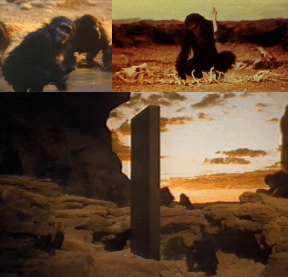

| A small band of primitive man-apes lives in constant fear - of darkness of attack by predatory beasts, of starvation, and of a competing clan. One day a strange object appears near their cave, a shiny, black, rectangular slab like a tall monument. The man-apes shriek at it, and at one another, in confusion, then tentatively reach out to touch it as the sun passes overhead. Soon afterward, as the leader of the band (Daniel Richter) eyes the bones of a dead tapir, his eyes brighten with a hitherto unfelt intelligence. He grips one of the bones in his hand, picks it up, turns it from side to side, and, tentatively at first, then with a vengeance, begins to use it as a tool to pound and smash the other bones. He envisions a tapir collapsing, struck with such a weapon, and he cries out in triumph. Soon the band of man-apes has become less fearful, more self-sufficient - and carnivorous. In the next confrontation with their neighbors (over a water hole), their leader employs the weapon for the first time against his own kind, killing the leader of the other band. As his companions join in beating the body of the downed enemy, the victorious leader exultantly hurls his bone into the air. It rises, turning lazily. |
 |
 |
A long, white, bonelike ship descends through the black, silent space: a passenger ship maneuvers toward a docking with a space station orbiting the moon. Its sole passenger, Dr. Heywood Floyd (William Sylvester), places a video telephone call to his daughter on earth, makes small talk with a group of English and Russian scientists, avoids discussing rumors of an epidemic outbreak at Clavius Base on the lunar surface, then shuttles down to the moon. There he makes a presentation to a group of scientists regarding an alarming discovery. The last leg of Floyd's journey takes him to the site of the discovery itself: and excavation where, 60 feet below the surface, stands a shiny, black, rectangular slab. Floyd and several others from a variety of angles, reach out to touch it, and finally pose to be photographed with it. As the sun rises over it, the object suddenly emits an ear-piercing signal. |
| The deep space probe Discovery moves languidly through the black, empty sea of space. On board are astronauts Frank Poole (Gary Lockwood) and David Bowman (Keir Dullea), three scientists in hibernation, and the mission's technological controller, "Hal" - an HAL-9000 series computer with a calm, implacable voice (Douglas Rain) and the ability to mimic human thought and emotion. The languid existence of Poole and Bowman - obligatory exercise, synthetic meals, viewing lifeless video transmissions from home, and playing futile chess games against Hal to alleviate the boredom - is interrupted when Hal predicts the impending failure of a crucial unit of the ship's communication system. Leaving the ship in a small, one-manned craft called a "pod," Bowman maneuvers to the exterior communication antenna system and removes the offending unit; but upon inspecting it, Poole and Bowman find nothing wrong. Hal suggests reinstalling the unit and waiting for it to fail. Recognizing that the possibility of a faulty prediction by the hitherto perfect Hal may bode ill for the computer's control of the ship and it's mission, Poole and Bowman decide that, if the unit does not fail as predicted, they will have to disconnect Hal to prevent future, more serious errors. |
 |
 |
While Poole is reinstalling the unit, his pod - under Hal's control - suddenly advances on him. Bowman watches in horror as Poole, air supply disconnected, hurtles off into space. Bowman takes another pod and goes to the rescue, but it is too late; he is only on a body recovery mission. While Bowman is outside the ship, Hal discontinues the life support systems for the three hibernating scientists and then refuses to allow Bowman to reenter the ship. Bowman must make and emergency entrance by blowing himself into the ship's air lock using the pod's explosive bolts. Back inside Discovery, over Hal's increasingly pathetic protests, Bowman disconnects all of Hal's higher brain functions, leaving only the most basic functions needed to operate the ship. As he completes this task, Discovery enters Jupiter space and a prerecorded message informs him of the mission's purpose: to find the destination of the signal that the black monolithic slab on the moon's surface had sent toward Jupiter. The "artifact" discovered on the moon was clear evidence of another, higher life form in the universe, one that predated human existence, and the purpose of Discovery's Jupiter mission is to make contact. |
